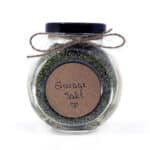If you found yourself with the happy problem of having an abundance of fresh garden herbs this season, you might be scrambling to find ways to use or store them before the cold weather rolls in.
Air drying, freeze drying and freezing are common ways to preserve fresh herbs, but there’s another way. An easy way…
Herb-infused salts
Infused herbal salts is a simple and practical way to preserve homegrown herbs and enjoy their flavors year-round!
Homemade herbal salts are as simple as combining fresh herbs with high-quality salt and buzzing them in the food processor for a sec. Then let the salt do its thing, drawing moisture out of the herbs through osmosis.
Osmosis is the movement of solvent molecules (typically water) from an area of lower solute concentration to an area of higher solute concentration through a semi-permeable membrane. In this case, the solute is the salt, and the solvent is the water present in our fresh herbs.
When herbs are chopped and mixed with salt, the salt acts as a powerful desiccant due to its high solute concentration. As the salt and chopped herbs are blended together, the osmotic pressure drives water molecules from the herb cells into the surrounding salt crystals. The salt essentially “pulls” the water out of the herbs. This process continues until equilibrium is reached, meaning the salt, herbs, and water achieve a balanced concentration of solutes.
The time it takes to reach full equilibrium and ensure thorough preservation will vary depending on factors like moisture content, ambient humidity and the salt-to-herb ratio. Herbs with high water content may take longer to reach equilibrium because there’s more moisture to be drawn out (and vice versa).
Bacteria and mold require moisture to thrive, so by drawing the water from the herbs, this process helps prevent microbial growth and spoilage, extending the shelf life of the fresh herbs.
Simultaneously, as the moisture is extracted, the aromatic oils and volatile compounds naturally present in the herbs are dissolved in the water. These oils carry the distinctive flavors and aromas of the herbs. Since the water is drawn into the salt, it carries the dissolved oils with it, infusing the salt crystals with the herb’s flavors and intensifying them.
After mixing, the herb and salt mixture is spread out and left to dry for a few days up to a week depending on the juiciness and water content of the fresh herbs. During this drying phase, any remaining moisture evaporates, leaving behind the salt infused with the concentrated flavors of the herbs.
Lovage "celery" salt
The taste of lovage (Levisticum officinale) resembles a strong, herbaceous celery with parsley-like undertone, so an herbal salt made using lovage makes it a lovely alternative to celery salt.
If lovage is not your bag, you can substitute virtually any herb for the lovage. Generally, you’ll want to use 2 to 3 parts salt to 1 part herbs. Leafy herbs are the easiest — they dry very quickly and you have a finished salt in a matter of hours. For juicier herbs and veggies and anything with excessive water content (such as hot peppers), I would aim for 3 parts salt to 1 part herbs. They will also take longer to dry. and may require stirring from time to time to achieve a thorough desiccation.
I find 3 parts salt to be preferable for any particularly strong tasting herb (looking at you, lovage). For milder tasting herbs or if you’d just like a stronger herb flavor, go with 2 parts salt to 1 part herbs. You can always add a bit more salt if it turns out too strong.
Here are a few leafy herbs that lend themselves to infusing in salt:
- basil
- borage aerial parts
- chervil
- chives
- cilantro
- coriander
- dandelion blossoms
- dill
- garlic
- kale
- lavender
- lovage
- nasturtium blossoms
- nettles
- oregano
- parsley
- peppermint
- rosemary
- sage
- salad burnet
- savory
- sorrel
- spearmint
- spinach
- Thai basil
- thyme
- viola blossoms




Preserving herbs with salt is a simple and effective way to capture the essence of your fresh garden herbs and have them available year-round for your culinary creations, even when there’s snow on the ground and they’re long out of season.
Homemade herb-infused salts also make thoughtful and personalized gifts for any friends and family who enjoy cooking (or eating, lol). Package in an attractive container, slap a bow on it and include a tag with recipe suggestions for a unique and thoughtful present! ♥

Lovage “Celery” Salt
5 Stars 4 Stars 3 Stars 2 Stars 1 Star
No reviews
Instructions
- Wash and thoroughly dry the fresh herbs. Remove any damaged or discolored leaves and stems.
- De-stem the lovage and discard (or compost) the stems.
- In the bowl of a food processor, combine 1 part lovage leaves with 3 parts salt. Process until lovage and salt are thoroughly blended.
- Transfer lovage salt to a baking tray with a rim (such as a jelly roll pan) lined with parchment, wax paper or a silicone baking mat. Spread salt in a thin layer. Loosely cover and allow to dry for a day or two until thoroughly dried and brittle.
- Break the dried lovage salt into chunks and return to the food processor. Process once more to powder.
- Transfer to a clean mason jar or glass shaker with an airtight lid. Label the container with the herb variety and date and store in a cool, dry place away from direct sunlight. Properly stored herbal salts should last a year or longer, depending on the herbs used and storage conditions.
- Use 1:1 for salt in recipes and on food.
Notes
Use high-quality, non-iodized mineral salt such as Real Salt or pink Himalayan. Iodized table salt may introduce unwanted flavors and additives.



